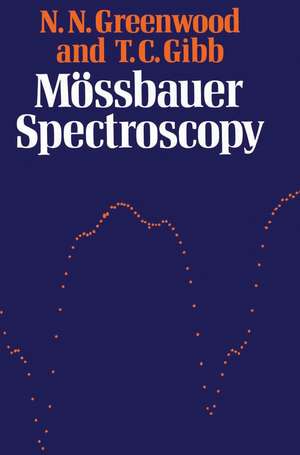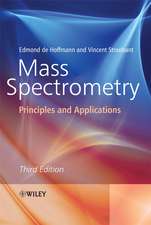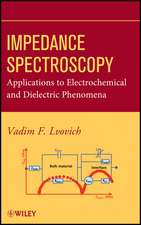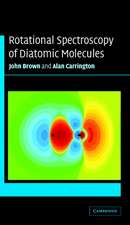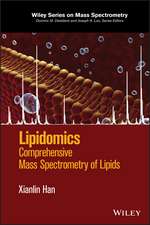Mössbauer Spectroscopy
Autor N. N. Greenwooden Limba Engleză Paperback – noi 2011
Preț: 962.35 lei
Preț vechi: 1173.60 lei
-18% Nou
Puncte Express: 1444
Preț estimativ în valută:
184.17€ • 199.98$ • 154.70£
184.17€ • 199.98$ • 154.70£
Carte tipărită la comandă
Livrare economică 23 aprilie-07 mai
Preluare comenzi: 021 569.72.76
Specificații
ISBN-13: 9789400956995
ISBN-10: 9400956991
Pagini: 676
Ilustrații: XII, 660 p. 118 illus.
Dimensiuni: 155 x 235 x 35 mm
Greutate: 0.93 kg
Ediția:Softcover reprint of the original 1st ed. 1971
Editura: SPRINGER NETHERLANDS
Colecția Springer
Locul publicării:Dordrecht, Netherlands
ISBN-10: 9400956991
Pagini: 676
Ilustrații: XII, 660 p. 118 illus.
Dimensiuni: 155 x 235 x 35 mm
Greutate: 0.93 kg
Ediția:Softcover reprint of the original 1st ed. 1971
Editura: SPRINGER NETHERLANDS
Colecția Springer
Locul publicării:Dordrecht, Netherlands
Public țintă
ResearchCuprins
1. The Mössbauer Effect.- 1.1 Energetics of free-atom recoil and thermal broadening.- 1.2 Heisenberg natural linewidth.- 1.3 Energy and momentum transfer to the lattice.- 1.4 Recoil-free fraction and Debye-Waller factor.- 1.5 Cross-section for resonant reabsorption.- 1.6 A Mössbauer spectrum.- 2. Experimental Techniques.- 2.1 Velocity modulation of gamma-rays.- 2.2 Constant-velocity drives.- 2.3 Repetitive velocity-scan systems.- 2.4 Derivative spectrometers.- 2.5 Scattering experiments.- 2.6 Source and absorber preparation.- 2.7 Detection equipment.- 2.8 Cryogenic equipment and ovens.- 2.9 Velocity calibration.- 2.10 Curve fitting by computer.- 3. Hyperfine Interactions.- 3.1 Chemical isomer shift, ?.- 3.2 Second-order Doppler shift and zero-point motion.- 3.3 Effect of pressure on the chemical isomer shift.- 3.4 Electric quadrupole interactions.- 3.5 Magnetic hyperfine interactions.- 3.6 Combined magnetic and quadrupole interactions.- 3.7 Relative intensities of absorption lines.- 3.8 Relaxation phenomena.- 3.9 Anisotropy of the recoilless fraction.- 3.10 The pseudoquadrupole interaction.- 4. Applications of the Mössbauer Effect.- 4.1 Relativity and general physics.- 4.2 Nuclear physics.- 4.3 Solid-state physics and chemistry.- 5. 57Fe — Introduction.- 5.1 The ?-decay scheme.- 5.2 Source preparation and calibration.- 5.3 Chemical isomer shifts.- 5.4 Quadrupole splittings.- 5.5 Magnetic interactions.- 5.6 Polarised radiation studies.- 5.7 Energetic nuclear reactions.- 5.8 The 136-keV transition.- 6. High-spin Iron Complexes.- A. High-Spin Iron(II) Complexes.- 6.1 Iron(II) halides.- 6.2 Iron(II) salts of oxyacids and other anions.- 6.3 Iron(II) complexes with nitrogen ligands.- B. High-Spin Iron(III) Complexes.- 6.4 Iron(III) halides.- 6.5 Iron(III) salts ofoxyacids.- 6.6 Iron(III) complexes with chelating ligands.- 7. Low-spin Iron(II) and Iron(III) Complexes.- 7.1 Ferrocyanides.- 7.2 Ferricyanides.- 7.3 Prussian blue.- 7.4 Substituted cyanides.- 7.5 Chelating ligands.- 8. Unusual Electronic Configurations of Iron.- 8.1 Iron(II) compounds showing 5T2?1A1 crossover.- 8.2 Iron(III) compounds showing 6A1?2T2 crossover.- 8.3 Iron(II) compounds with S = 1 spin state.- 8.4 Iron(III) compounds with S = 1/3 spin state.- 8.5 Iron 1,2-dithiolate complexes.- 8.6 Systems containing iron(I), iron(IV), and iron(VI).- 9. Covalent Iron Compounds.- 9.1 Binary carbonyls, carbonyl anions, and hydride anions.- 9.2 Substituted iron carbonyls.- 9.3 Ferrocene and other ?-cyclopentadienyl derivatives.- 10. Iron Oxides and Sulphides.- 10.1 Binary oxides and hydroxides.- 10.2 Spinel oxides AB2O4.- 10.3 Other ternary oxides.- 10.4 Iron(IV) oxides.- 10.5 Iron chalcogenides.- 10.6 Silicate minerals.- 10.7 Lunar samples.- 11. Alloys and Intermetallic Compounds.- 11.1 Metallic iron.- 11.2 Iron alloys.- 11.3 Intermetallic compounds.- 12. 57Fe — Impurity Studies.- 12.1 Chemical compounds.- 12.2 Metals.- 12.3 Miscellaneous topics.- 13. Biological Compounds.- 13.1 Haemeproteins.- 13.2 Metalloproteins.- 14. Tin-119.- 14.1 ?-Decay scheme and sources.- 14.2 Hyperfine interactions.- 14.3 Tin(II) compounds.- 14.4 Inorganic tin(IV) compounds.- 14.5 Organotin(IV) compounds.- 14.6 Metals and alloys.- 15. Other Main Group Elements.- 15.1 Potassium (40K).- 15.2 Germanium (73Ge).- 15.3 Krypton (83Kr).- 15.4 Antimony (121Sb).- 15.5 Tellurium (125Te).- 15.6 Iodine (127I, 129I).- 15.7 Xenon (129Xe, 131Xe).- 15.8 Caesium (133Cs).- 15.9 Barium (133Ba).- 16. Other Transition-metal Elements.- 16.1 Nickel (61Ni).- 16.2 Zinc (67Zn).- 16.3 Technetium (99Tc).- 16.4Ruthenium (99Ru).- 16.5 Silver (107Ag).- 16.6 Hafnium (176Hf, 177Hf, 178Hf, 180Hf).- 16.7 Tantalum (181Ta).- 16.8 Tungsten (182W, 183W, 184W, 186W).- 16.9 Rhenium (187Re).- 16.10 Osmium (186Os, 188Os, 189Os).- 16.11 Iridium (191Ir, 193Ir).- 16.12 Platinum (195Pt).- 16.13 Gold (197Au).- 16.14 Mercury (201Hg).- 17. The Rare-earth Elements.- 17.1 Praseodymium (141Pr).- 17.2 Neodymium (145Nd).- 17.3 Promethium (147Pm).- 17.4 Samarium (149Sm, 152Sm, 154Sm).- 17.5 Europium (151Eu, 153Eu).- 17.6 Gadolinium (154Gd, 155Gd, 156Gd, 157Gd, 158Gd, 160Gd).- 17.7 Terbium (159Tb).- 17.8 Dysprosium (160Dy, 161Dy, 162Dy, 164Dy).- 17.9 Holmium (165Ho).- 17.10 Erbium (164Er, 166Er, 167Er, 168Er, 170Er).- 17.11 Thulium (169Tm).- 17.12 Ytterbium (170Yb, 171Yb, 172Yb, 174Yb, 176Yb).- 18. The Actinide Elements.- 18.1 Thorium (232Th).- 18.2 Protactinium (231Pa).- 18.3 Uranium (238U).- 18.4 Neptunium (237Np).- 18.5 Americium (243Am).- Appendix 1. Table of nuclear data for Mössbauer transitions.- Appendix 2. The relative intensities of hyperfine lines.- Notes on the International System of Units (SI).- Author Index.
